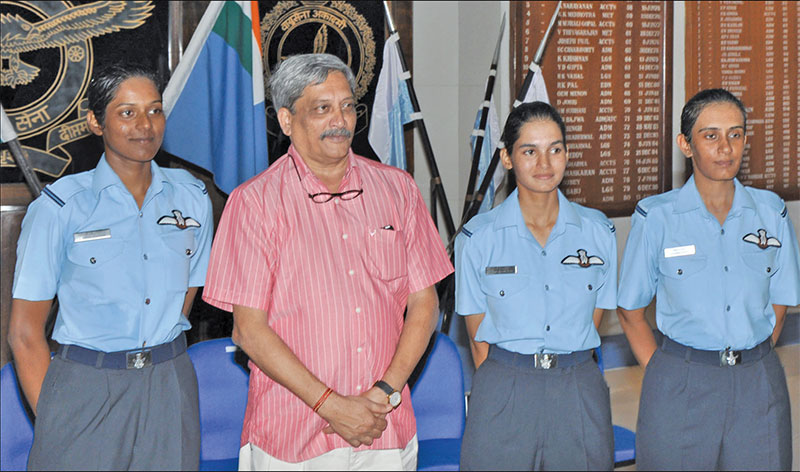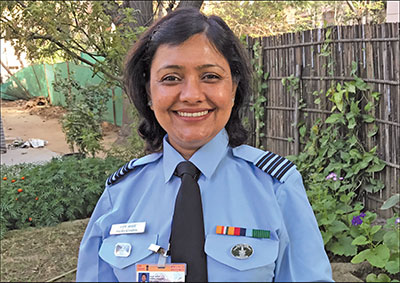It is commendable the IAF has opened new roles for women officers but more needs to be done
Yunus Dar
Three women, Avani Chaturvedi, Bhawana Kanth and Mohana Singh made history in 2017 when they were selected as the first women fighter pilots in the Indian Air Force (IAF), after the government made the decision in 2015 to allow the women to take on the new roles. The women officers until 2017 could fly only transport aircraft and the helicopters in the IAF, and with the new decision by the government opening the fighter pilot positions for them, gave them an opportunity to prove their mettle in combat roles.

The IAF, for the first time, allowed women in operational duties in 1992, before which they were only present in the medical branch of the force. The women doctors and nurses had been serving in all three services from the beginning. The following year, 1993 saw the induction of the first batch of seven women for the pilots’ course. On 2 September 1994, the 22-year-old Harita Deol made history when she flew solo in an Avro HS-748, the first woman to fly in the IAF without any co-pilot.
The IAF employs the largest percentage of women officers among the three defence services, currently having over 1,594 women officers in service, of which more than a 100 are frontline pilots. In the last three years, the IAF has continued with the trend by inducting the largest percentage of women into its fold. Until 2015, they were consigned to ground and technical duties in the force, and while they could fly other aircraft, induction as fighter pilots was a long-sought dream.
The IAF continues to remain a favourite for women among the three services, which the analysts say is because it offers them flying opportunities and the combat offers, besides, a grooming and thrilling environment.
The IAF has been inducting women in the areas of administration, logistics, meteorology, navigation, education, aeronautical engineering and accounts, and while the army and the navy are yet to give them combat roles, the IAF has led the way with its decision in 2015.
Women find the IAF as the best career choice amongst the three services, for a variety of reasons. Wg Cdr Anuma Acharya (retd) says the best part about joining the service was (and would ever remain) the life in uniform, discipline, dignified and challenging profile with a room for a lot of fun.
“I have actually got exposed to a more positive side of the profession and can also state that I learnt to live life in the IAF paving ways beyond the horizon. Despite being a toddler in professional life of the IAF, I was offered to learn every detail, excel steadily and subsequently, turn into an exemplary professional,” she adds.

Way back in February 2018, Avani Chaturvedi became the first Indian woman to fly the MiG 21 Bison, solo, setting an example for other women that they were equally capable in combat missions. While women in other countries have flown fighter jets for a long time, the decision came very late in India. But, better late than never. Increasing number of women are now choosing the IAF as a career as the government keeps opening new avenues for them and offering newer opportunities and roles.
Avani became a role model for the girls intending to join as fighter pilots, which wasn’t the case earlier, consequently, the number of female pilots aspiring for the IAF has significantly increased. Initially, this wasn’t the case, because such a feat was impossible. After allowing women to fly the fighter aircraft, India joined the ranks of the United States, China, France, Turkey, Greece, the UK and Pakistan; all of which have women fighter jet pilots.
“Presently, the environment has turned very conducive and normal for women officers in the IAF. In the last 25 years, the organisation and the people have become accustomed to the presence and performance of women officers. Newer fields (intra-organisation) are opening for women; however, promotion related biases continue due to the inbuilt sympathy factor with the male officers, who are the bread-winner for their families. Women officers are always envied being from the double income group and, therefore, miss out on such sympathy factors prevail unconsciously within the organisation,” Anuma adds.
Wg Cdr Pooja Thakur (retd) led the ceremonial guard of honour to visiting US President Barack Obama, in 2015. She says, “The best moment in the IAF was being the first women in the history of India to command a Tri Services Guard of Honour, to be able to successfully perform the duty entrusted onto me by the services. But more so, to see the pride in the eyes of women across the country for being the symbol of their progress in varied fields.”
Pooja says that as a career, the IAF broke the shackles of stereotypical roles that a woman could pursue, two decades earlier. “The best part about joining the service was the fact that with grit and perseverance, I could create a niche, in a predominantly male-dominated environment; whether it be adventure sports (World Military Parachuting Championship) or giving a Guard of Honour to the President of the United States,” she remembers.
Another officer, Padmavathy Bandopadhyay, broke the glass ceiling when in 2004, she became the first woman Air Marshal in the IAF, taking over as Director General Medical Services (Air). She also had the distinction of being the first woman officer to become an aviation medicine specialist. She was awarded the Visisht Seva Medal for her meritorious service during the 1971 Indo-Pak conflict.
Squadron Leader Khushboo Gupta, the first woman helicopter pilot to land at forward posts on the Siachen glacier, despite being told by her peers that she couldn’t achieve this feat. Today, she is one of the two women serving in the Leh-based 114 Helicopter Unit, called the Siachen Pioneers.
Similarly, in 1995, two women pilots, Simran Sodhi and Cheryl Dutta, invaded the skies by flying a Chetak helicopter, becoming the first to do so in the Indian subcontinent. In 1991, women officers in the IAF were to be inducted on experiment basis for five years, if it turned out to be successful, the officers were to be offered another six years extension. “We had faced challenges of all kinds that included non-availability of toilets for women officers. Being the first ones to be posted at our new stations, staff slowly got acquainted with our potential to learn and work. There were inhibitions, doubts, overprotective and sometimes even envious attitude from teammates and male colleagues,” says Anuma.
“Yet, more than the challenges, we always had the will power to adaptability and that is how we could ensure the experiment was as a success by the end of the fifth year of our service and got our first extension for another six years,” she adds.
Anuma says she fully endorses more women should join the IAF, this being one among the most reputed, secured and satisfying services in India, where women officers live and perform in a protective environment and their respect is ensured by the organisation as a prime responsibility.
How far up do the women go in the IAF? The former IAF Wing Commander says opportunities for growth diminish for women officers as the pyramid turns steeper with time. Barring education branch, so far only one women officer of Admin Branch could get a promotion to the rank of Group Captain.
“Unfortunately, despite being more competent, many of the women officers could not be promoted to the next rank succumbing to factors not attributed to their performance but were related to circumstantial factors and cadre-based completion of all other more prominent branches (verticals) of the IAF,” she says. She says the environment is changing for the better now as more and more women join, and infrastructure and facilities are created for them.
As new doors open for women in the force, there is a lot more to be done to create a positive and growing environment in the IAF. Having the largest number of women amongst the three services is a commendable feat for the IAF, however that number is still very low. Perhaps, it’s time the women of the country are entrusted greater responsibilities and unprecedented roles in the armed forces, and it’s time to give them equal footing in the arenas of the battlefield.

